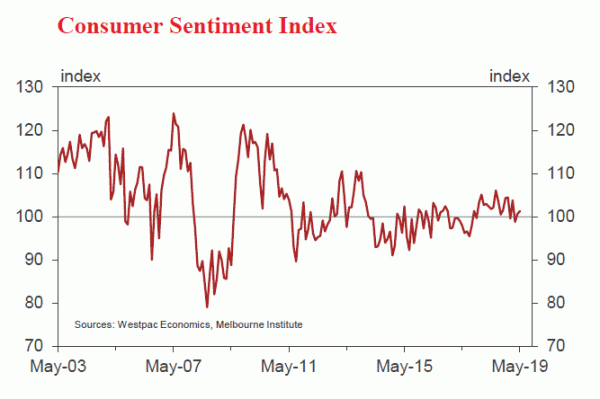The overall movement in the Index in May is modest. It is also important to note that the Index has held above 100 for ten of the last twelve months.
Last month’s survey showed a clear boost from the Federal Budget, which was in the middle of the April survey period. Readings before the Budget announcement were much lower than in the post Budget period, indicating that it had been well received by consumers.
Indeed the post-Budget Index reading was 104.3 meaning that sentiment in May has deteriorated by around 3% compared to post Budget levels. This probably reflects some ‘cooling off’ from the initial confidence boost, which was substantial.
Despite the Reserve Bank ultimately deciding not to cut the cash rate at its May Board meeting it is likely that households are much more confident this month than previously that interest rates are likely to come down further. Media coverage both pre and post the Reserve Bank decision is pointing strongly to eventual interest rate relief.
The component indexes showed mixed moves this month. The sub-index tracking assessments of ‘family finances vs a year ago’ showed a strong 6.3% gain in May. The post Budget survey result surprisingly showed no real lift in this component. The May lift is probably reflecting a delayed positive response to the Budget, along with the more optimistic outlook for interest rates. Note that this component had fallen by 10% over March/April and remains well below its long run average level.
Consumer expectations for ‘family finances next 12 months’ slipped 1.6% following a solid 4.1% lift in April that reflected the tax measures in the Budget. However, this component is also below its long run average.
Sentiment around the economy also had a mixed month, with the ‘economic outlook, next 12 months’ sub-index rising 2.3% but the ‘economic outlook, next five years’ sub-index declining 2.9%.
Attitudes towards spending were largely unchanged with the ‘time to buy a major household item’ sub-index edging up 0.3% to 115.8, a positive read but down 4.5% on a year ago and well below the long run average of 127 and the post Budget print of 121. The readings around both current finances and ‘time to buy a major item’ remain consistent with the weak consumer spending growth seen through the second half of 2018 and the flat real retail sales print for the March quarter.
Job loss fears eased again in May. The Westpac-Melbourne Institute Unemployment Expectations Index recorded a 5.1% decline (recall that lower readings indicate that fewer consumers expect unemployment to rise in the year ahead). At 120.9 the index is back near recent lows and still comfortably below the long run average of 130.
Sentiment around housing deteriorated in May. The ‘time to buy a dwelling’ index fell 3.8% to 114.9 in May, retracing from what was a four year high in April. The index has risen 28% from its mid-2017 low but is below its long run average of 120. Improving affordability continues to see a lift in buyer sentiment in New South Wales and Victoria with the May pull back more pronounced in Queensland and Western Australia.
The Westpac-Melbourne Institute Index of House Price Expectations posted a 6.5% drop, partially retracing the surprisingly strong 11.9% rise in April. Price expectations have been particularly volatile in New South Wales in recent months, but have still improved slightly since the start of the year. In contrast, price expectations have been pared back in Queensland and Western Australia, the latter showing a particularly sharp fall into negative territory and a two and a half year low in May.
The Reserve Bank Board next meets on June 4. On February 21 Westpac predicted that the Board would adopt an easing bias at its May meeting prior to cutting the cash rate at its August and November meetings.
Last week we saw the easing bias delivered following the May meeting and the Statement on Monetary Policy. The Bank has lowered its growth and inflation forecasts to levels that are barely acceptable – slightly below trend for growth and below 2% for core inflation.
Importantly, those forecasts are based on market pricing for interest rates which have a full rate cut priced in for August and another fully priced for the first half of 2020 – slightly more cautious than Westpac’s forecasts.
So, even with rate cuts, the Bank’s forecasts are barely acceptable. However the Bank is still somewhat puzzled by the tension between strong labour market prints (supported by today’s survey) and the weak GDP and partial data. We expect that will be resolved over the next few months with the case for the August cut becoming clear. Markets and many commentators are more impatient, expecting a move as early as the June meeting. We think it will take more than one or two months’ data for the issue to be resolved by the Bank














